
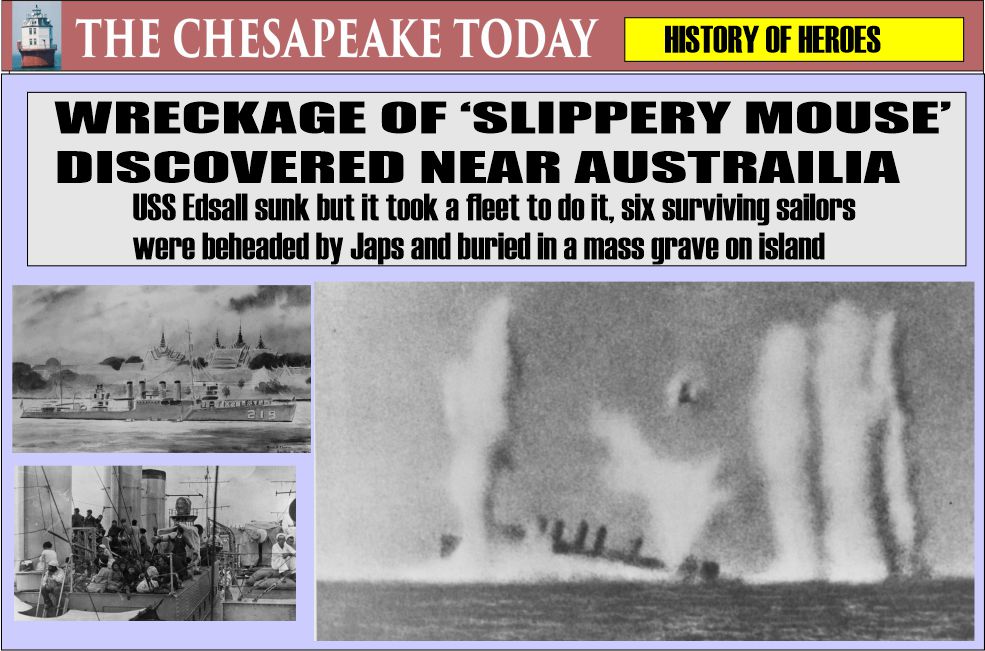
Edsall I (DD-219)
1920-1942
Named for Norman Eckley Edsall, born on 3 June 1873 in Columbus, Ky., who enlisted in the Navy as a seaman on 27 June 1898. While serving on board Philadelphia (Cruiser No. 4), on 1 April 1899, Seaman Edsall went ashore with a landing party under the command of Lt. Philip V. Lansdale to suppress hostile natives near Apia, Samoa. The thicket was so dense that when the order to withdraw was sounded it was impossible for the different units of the expedition to provide mutual support. Lt. Lansdale was wounded below the knee and unable to march. Edsall was mortally wounded while assisting Lt. Lansdale to cover. Having died from his wound, he was buried on Samoa.
(DD-219: displacement 1,190 tons; length 314’4″; 30’8″; 9’3″; speed 35 knots; complement 122; armament 4 4-inch/50 caliber, 1 3-inch/23 caliber; 12 21-inch torpedo tubes; class Clemson)
The first Edsall (Destroyer No. 219) was laid down on 15 September 1919 at Philadelphia, Pa., by William Cramp & Sons; reclassified as DD-219 on 17 July 1920 as part of a Navy-wide standardization of alphanumeric identification numbers; launched on 29 July 1920; sponsored by Mrs. Bessie Edsall Bracey, sister of Seaman Edsall; and commissioned at the Philadelphia Navy Yard on 26 November 1920, Cmdr. Arthur H. Rice Jr., in command.
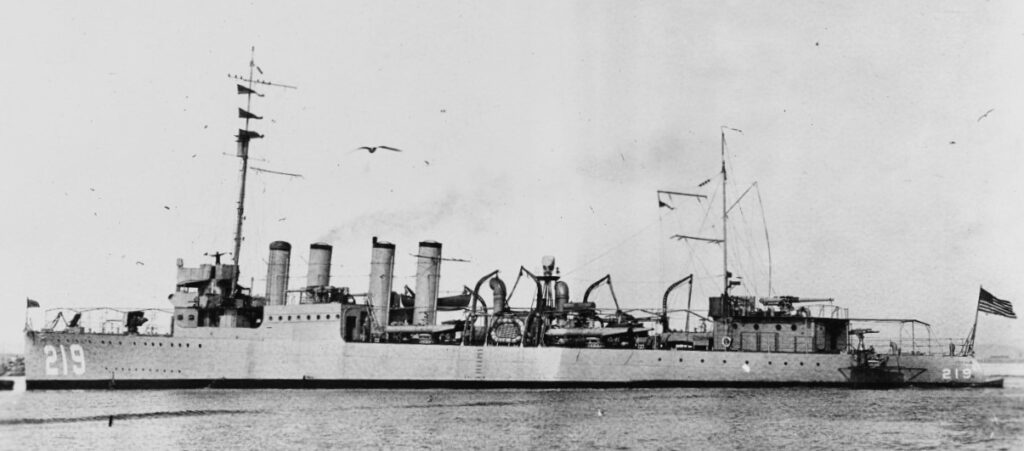
Edsall cleared the Philadelphia Navy Yard on 6 December 1920 for her shakedown cruise en route to her duty station at San Diego, Calif. Having made stops at Newport, R.I. (7 December; New York Navy Yard, Brooklyn, N.Y. (11-13 December); and Hampton Roads, Va. (14-16 December), the destroyer arrived at the Charleston (S.C.) Navy Yard on 18 December. Underway four days later, on 22 December, she steamed to Havana, Cuba, where she arrived on 24 December. Having spent the Christmas holiday in port, she was underway again on the 27th. Touching at Key West, Fla., (27-28 December) in advance of reaching Cristóbal, Canal Zone (C.Z.), the anchorage at the Panama Canal’s Atlantic entrance, on New Year’s Eve.
After transiting the Panama Canal into the Pacific after the New Year, Edsall departed Balboa on 3 January 1921 for Salina Cruz, Oaxaca, Mexico (5-7 January) and later arrived at San Diego on 11 January 1921. She spent the next several months operating from her base at San Diego conducting battle practices and gunnery drills with fleet units. On 3 June, she steamed to the Pacific Northwest to visit Portland, Ore. (6-11 June), and then returned to San Diego on 14 June. Underway the next day, she conducted a week’s training at sea and then returned to her berth at San Diego on the 22nd. She then cleared on 26 June for a short trip to Monterey, Calif. Arriving the next day, she remained there until shifting to San Francisco on 1 July. Underway again on 7 July, she steamed back into San Diego on 9 July. After getting underway for additional short-term training exercises through the summer and into the autumn, Edsall departed San Diego on 2 October and steaming into San Francisco Bay, entered the Mare Island Navy Yard, Vallejo, Calif., on 3 October. After undergoing maintenance through 20 November, she departed that same day and stood back into San Diego on the 21st. About two weeks later, Edsall sortied from San Diego to make her return to the Atlantic. First steaming to the Canal Zone (12-16 December), she continued on to Guantánamo (19-26 December) before returning to the Charleston Navy Yard on 28 December to spend the New Year’s holidays in port.
Edsall was again underway on 3 January 1922 and steamed into the Philadelphia Navy Yard on 5 January to undergo maintenance and preparation for a deployment to Europe and the Middle East. She undocked on 10 March and steamed to Charleston. Arriving there on 12 March, she entered the yard and underwent an additional two months of preparatory yard work before departing on 26 May and making her return to Philadelphia on the 28th. Steaming out of the yard and down the Delaware Bay on 6 June, Edsall initially visited Newport (7-12 June) before she crossed the Atlantic. Reaching the British crown colony of Gibraltar on 21 June, she remained there two days before departing. Transiting the Mediterranean Sea, the destroyer steamed into the Aegean and passed through the Dardanelles, to anchor off the Golden Horn at Constantinople, Turkey [Istanbul, Türkiye], on 29 June. Upon her arrival, Edsall joined the U.S. Naval Detachment in Turkish Waters to protect U.S. lives and interests. This theater adjacent to the Black Sea writhed in turmoil with civil war in Russia and the ongoing Greco-Turkish War/Turkish War of Independence. Edsall and her crew advised and assisted the multiple American relief organizations, helped evacuate refugees; provided chains of communications where it had been disrupted or ceased to operate; supported efforts to alleviate postwar famine in eastern Europe, and generally stood by in the event of emergencies.
Edsall, in support of these missions, got underway on 9 August 1922. Steaming through the Bosporus, she crossed the Black Sea to Odessa, Russia [Odesa, Ukraine], arriving on the 10th. After nine days, she departed on 19 August, and steaming around the Crimean Peninsula into the Sea of Azov and stood into Novorossiysk, Russia (20-30 August). She then moved on to Batum, Russia [Batumi, Georgia] (30-31 August); Trebizond [Trabzon], Turkey (31 August); and Samsun, Turkey 92-7 September) before returning to Constantinople on 8 September. She soon got underway on 13 September, steaming to the largely ethnic Greek city of Smyrna [Izmir]. She arrived off the city the next day. Comdr. Halsey Powell, Edsall’s commanding officer, replaced Capt. Arthur J. Hepburn, chief of staff for Rear Adm. Mark L. Bristol, U.S. High Commissioner in Turkey, as the Senior Officer Present (SOP) for the U.S. ships in the port. That same day an advancing Turkish army set fire to the city’s Greek quarter and Edsall embarked 607 refugees from Litchfield (DD-336) and transported them to and disembarked them at Salonika, Greece. She returned to Smyrna on 16 September to serve as flagship for the naval forces there. Later, on 21 October, she transported refugees from Smyrna to Mytilene on Lesbos Island, Greece. Continuing on, she touched at Chios, Greece, on 22 October en route to a return to Constantinople. The following month, 23-29 November, the destroyer visited Varna, Bulgaria before returning to Constantinople on 30 November. She was then underway in the Black Sea through most of December, making visits to Sansum (1-2 December); Trebizond (3-4 December); Samsun (5-19 December); Ordu (19-20 December); Samsun (20-21 December) before returning to the Golden Horn on 22 December to spend the Christmas holiday in port. On Boxing Day, she stood out into the Black Sea then returned to Constantinople on New Year’s Eve.
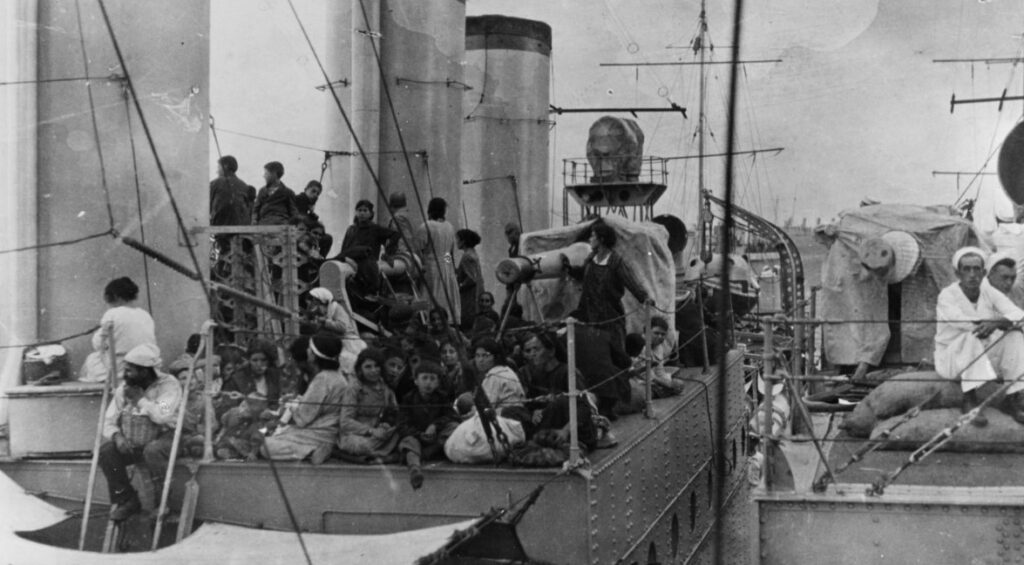
Caption: Refugees on board Edsall during the evacuation of Smyrna after its capture by the Turkish Army. Collection of Admiral Thomas C. Kinkaid. (Naval History and Heritage Command Photograph NH 85298)
Having welcomed 1923 moored off Constantinople, it would not be until 18 January that Edsall would again be underway. Bound for Smyrna, she arrived on 19 January and maintained a presence around the city and its environs until 15 March, when she steamed for Constantinople, arriving at her destination the next day. A week later, on 23 March, she weighed anchor and got underway for Mersina, Turkey [Mersin, Türkiye] but made a quick return to her anchorage at Constantinople. Nearly a week later on 29 March, she did get underway and steamed to Smyrna and arrived the following day. From there she steamed across the Mediterranean to Alexandria, Egypt (1-11 April) before moving on to Haifa, British Mandate of Palestine [Israel] (11-14 April); Beirut, French Mandate of Syria [Lebanon] (14 April); Mersina (15-18 April); and Alexandretta, French Mandate of Syria [Iskenderun, Türkiye] (18-20 April). Returning to Smyrna (22-30 April), she then visited Athens’ port city of Piraeus, Greece (2-3 May) and cruised in the Aegean until making her return to Constantinople on 5 May. Several days later, on the 9th, she steamed into the Black Sea to visit Mudania, Turkey [Mudanya, Turkiye], on the northern Anatolian coast then returned through the Bosporus to anchor in Sar Sighlar Bay, Turkey (10-12 May) before returning to Constantinople on 12 May. Edsall stood out through the Bosporus and into the Black Sea on 6 June and visited Samsun (7 June; 9-13 June; 16-17 June); Trebizond (8 June); and Feboli, Turkey (14-15 June), before returning to the Turkish capital on 18 June.
After more than a month at anchor, Edsall departed for Varna on 25 July 1923. Reaching her destination that same day, she remained until 3 August, when she transited the Black Sea to Samsun (4-11 August) in advance of her return to Constantinople on the 13th. She then steamed to Smyrna (29 August-3 September) and after a term at Constantinople, she departed on 28 September to cruise in the Black Sea, visiting multiple ports during this time. These included visits to Varna (29 September-20 October; 28 October-8 November); Samsun (22 October; 26 October); and Trebizond (23-25 October) before standing back into Constantinople on 8 November). After two days in port, she was again underway transiting the Aegean bound for Smyrna (11-12 November); Piraeus (13-19 November), Mudros, Greece (19 November); Thaso Straits 21-27 November); Salonika (28-30 November); and Kavala, Greece (30 November-3 December) before returning to Constantinople on 4 December. Edsall was again underway on 10 December to make port calls in Greece, visiting Dedeagach [Alexandroupolis] (10-11 December); Kavala (11-12 December); and Piraeus (12-21 December) before anchoring in the Salamis Straits (21-28 December), then returning to Piraeus on the 28th to celebrate the New Year in port there.
Edsall was underway again on 4 January 1924, steaming to Mudros (5-12 January), before making a brief return to Piraeus (14-15 January). She then visited Messina, Sicily, Italy (16-19 January) and Algiers, French Algeria [Algeria] (21-26 January). She then departed for Tunis, French Tunisia [Tunisia], but diverted and steamed to Naples, Italy, instead (1-9 February). The destroyer then set a course for Port Said, Egypt, the northern terminus of the Suez Canal (12-18 February) before departing for Haifa. She again diverted and steamed to Piraeus (21-29 February) before visiting Mudros (1-8 March) and Kavala (16-19 March). Returning to Piraeus one last time (19 March-23 April) before steaming into the Adriatic and standing into Spalato, Kingdom of Serbs, Croats, and Slovenes (Yugoslavia) [Split, Croatia] on 25 April. She remained in port until 8 May, when she steamed north to Venice, Italy (8-14 May). Clearing on the 14th, she transited south past her initial destination of Spalato and on to Naples (16 May-2 June). She then visited additional Italian ports Leghorn (2-9 June) and Brindisi 11-12 June) before calling at Durazzo [Durrës], Albania (12-16 June). She then steamed, via Brindisi (16-20 June), to Genoa, Italy (22-26 June) before transiting the western Mediterranean, reaching Gibraltar on 28 June. Departing on Independence Day, she headed west to cross the Atlantic back to the United States. Steaming through the Verrazano Narrows into New York Harbor then on to the Hudson River, anchoring at North River off Manhattan (15-25 July). After liberty in New York City, she steamed to the Boston Navy Yard, Charlestown, Mass., for much needed maintenance and modifications to prepare for her next assignment on the Asiatic Station. She docked on 26 July and underwent yard work until 15 December. After undocking and post-repair trials, she steamed to the Philadelphia (Pa.) Navy Yard, arriving the next day, 16 December, and remained there through the holiday season.
Having spent New Year’s Day 1925 in port, Edsall departed Philadelphia for the Asiatic Station on 3 January. En route she stopped at Guantánamo Bay, Cuba, on 7 January to participate in battle practice and maneuvers during the annual Winter Battle Practices in the Caribbean. These exercises included visits to Gonaïves, Haiti (19-30 January) and Guacanayabo Bay, Cuba (1-4 February). Returning to Guantánamo on 5 February, she remained there until departing on the 14th for the Canal Zone and her passage into the Pacific. She reached Colon on the 17th and after having transited the canal she departed from Balboa for San Diego on 24 February. After over a month at San Diego (12 March-16 April), Edsall went to sea bound for the Hawaiian Territory (H.T.). Reaching Honolulu on 27 April, she went to sea again on 8 May. The destroyer then spent the next two weeks conducting training in Hawaiian waters and visiting the anchorages at Lahaina Roads, Maui, and Hilo, Hawaii. She entered Pearl Harbor on 23 May and after four days, she departed on the 27th to cross the Pacific to her new assignment. She briefly stopped at Midway Island, H.T., on 3 June and reached China, standing into Chefoo [Yantai] (14-19 June) before arriving at Shanghai on 22 June.
Edsall became a fixture of the U.S. Asiatic Station on the China coast, in the Philippines, and Japan. Her service, and that of her fellow destroyers on the Asiatic Station, typically consisted of spending the summer months cruising in Chinese waters and the winter months navigating the Philippine archipelago. Their primary duty was protection of U.S. interests in the Far East. Edsall faithfully served through warlords, revolution, and civil war in China; the Shanghai Incident of 1932; and the outbreak of the Second Sino-Japanese War in 1937.
On 9 July 1925, Edsall went to sea departing Shanghai and arrived in Amoy [Xiamen[ on 12 July. Throughout the remainder of the summer, she visited Swatow [Shantou], Chefoo, the British Crown Colony of Hong Kong, and Tsingtao [Qingdao]. On 15 September, Edsall departed the China coast and made a five-day transit to Manila, Luzon, Philippines. After her arrival on the 20 September. She entered the Navy Yard at Cavite and spent the fall months undergoing maintenance. Departing for Shanghai on 30 November she arrived on 4 December and spent the remainder of the month in port, departing for Manila on the final day of 1925.
Underway on New Year’s Day, Edsall stood into Manila on 2 January 1926. Following a month in port she put to sea for one day on 3 February and then steamed for Olongapo (Subic Bay), Luzon, Philippines, on 9 February. Arriving on the 10th, Edsall spent two days in port before returning to Manila on the 12th. For the remainder of the month and into March, she put to sea four times in Philippine waters before visiting the Cavite Navy Yard (10-11 March) and arriving in Shanghai on 19 March. After nearly two months in Shanghai, Edsall journeyed to Hankow [Hankou], Nanking [Nanjing], and Woosung [Wusong] in the final weeks of May. She stood into Chefoo on 1 June and remained for the balance of the summer, not departing for Hong Kong until 5 October. After a three-day voyage to Hong Kong, the crew made steam for Manila on 14 October. After anchoring at Manila and Cavite on 16 and 18 October, respectively, she cruised throughout the Philippines– Olongapo (19-22 October); Manila (23-24 October); Cebu (26-29 October); and Dumaguete (29-30 October. After spending the first six days of November in Manila, Edsall visited Olongapo on the 8th before making a passage to Mariveles, Luzon (9-10 November) the following week. She went to sea twice more (16-18 November and 23-24 November) before returning to spend the remainder of 1926 in port.
The New Year 1927 brought Edsall’s return to Chinese waters. She departed Manila on 4 January and arrived in Shanghai on the 12th. After a time in port, she weighed anchor on 2 March and returned to Manila by way of Steep Island (2-3 March), Turnabout [Niushan] Island (4-5 March), Itbayat, Philippines (7 March), and the Babuyan archipelago, Philippines (8 March). Edsall reached Manila on 9 March and remained in port until the 21st, when she stood out for Mariveles (21 March), returning to Cavite on the 23rd, to clear for Swatow on 25 March. Touching at Swatow on the 26th, she cruised the Chinese coast before arriving at Shanghai on 18 April. Edsall then spent three weeks before steaming up the Yangtze River via Woosung [Wusong] (10-11 May) and “Wild Boar Reach” (12 May), to arrive at Hankow [Hankou] on 14 May. After 27 May, she made two separate passages to Chenglin [Tianjin] 29 May-2 June; 11 June), before departing Hankow on 12 June to return to Shanghai on the 15th.
On 2 July 1927, Edsall and her crew stood out from Shanghai, dropping anchor at Chefoo the following day. She spent nearly eight weeks in port before touching at Woosung (21 August) and Shanghai (22 August) on her way to the Navy Yard at Cavite. Docking for maintenance on 25 August, she completed her yard work and departed Manila on 27 September for a return to China, reaching Shanghai on 1 October. Throughout October and into November, Edsall and her crew navigated Chinese waters with short visits to Hankow (5-6 October), Wuhu (7-9 October), Kiukiang (11 October), Wuhu (11-23 October), Shanghai (24 October), and Hong Kong (28 October) before venturing south for Bangkok, Siam [Thailand] (2-7 November) and then Saigon, French Indochina [Ho Chi Minh City, Vietnam]. On 15 November, Edsall made her seasonal return to the Philippines, anchoring in Manila Bay on the 19th. Nine days later, on 28 November 1927, Edsall left Manila for Mariveles, arriving that same day. She returned to Manila on 29 November and repeated the Mariveles passage a second and third time in early December. On 13 December, Edsall steamed from Mariveles to Cavite, spent five days in port, and continued to Olongapo on the 18th. After four days there, she weighed anchor for Manila Bay, where she spent the remainder of the year and the first three weeks of January 1928.
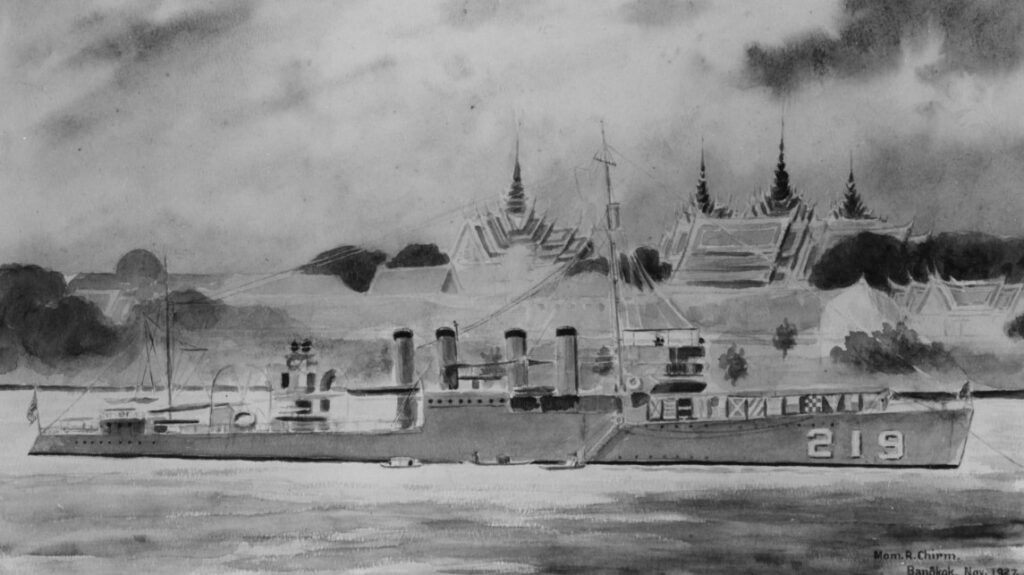
Caption: Painting of Edsall at Bangkok in 1927 by Mom. R. Chirm. (Naval History and Heritage Command Photograph NH 91717)
After a quiet start to 1928, Edsall weighed anchor on 25 January, steaming to Mariveles (25-26) then returned briefly to Manila Bay before moving to Olongapo and then shuttling between the two locations (27-29 January), before mooring in Subic Bay (29-30 January). On the final day of January, Edsall steamed back into Manila Bay. Underway on 1 February, she visited Mariveles and then Subic Bay before returning to Manila on 3 February to spend most of the month in port there. She then shuttled between Manila and Mariveles (27 February-1 March). On 4 March, Edsall ventured to Mamburao, Mindoro, then returned to Manila the following day. The destroyer transited the Verde Island Passages and Tayabas Bay on 7 March, then proceeded to Bulalacao, Verde Island Passages, and Lutang Island on 8 March. She returned to Manila Bay that same day and got underway in local waters twice before steaming for a return to China on 21 March. Edsall arrived at Swatow on the 23rd and spent four days in port before steaming to Hong Kong (28 March-4 April). She spent the month of April in a rapid sequence of visits to Amoy (4-6 April), Foochow [Fuzhou] (7-8 April), Samsa Inlet (8-10 April), Alacrity Bay (12-14 April), before crossing the East China Sea to Nagasaki, Japan (15-25 April). She then returned to China, remaining at Chefoo (27 April-15 May). Edsall then visited Chinwangtao [Qinhuangdao] (15-24 May) before returning to Chefoo on the 25th. Going to sea for one day on the 29th, the ship returned to Chefoo on 30 June.
Edsall stood out from Chefoo on 9 July 1928 and stopped in Amoy before returning to the Philippines. She steamed into Manila Bay and underwent maintenance at the Cavite Navy Yard (16 July-10 September). After a visit to Olongapo (11-19 September) Edsall returned to Manila on the 20th before clearing for China on the 25. She re-entered the Yangtze and moored off the International Settlement in Shanghai on 29 September. In October, the destroyer commenced an ambitious operational season. Weighing anchor on the first of the month, she anchored in Alacrity Bay (2-8 October), visited Woosung (9 October) then returned to Shanghai the following day. She then made turns, steaming up the Yangtze to Chinkiang (14-16 October). In the final two weeks of October, Edsall continued her Yangtze cruise, visiting Wuhu (16-17 October), Kiukiang [Jiujiang] (18 October), Hankow [19-23 October], Anking [Anqing] (23-24 October). Reversing course on 24 October, the destroyer touched at Chinkiang (25 October), Woosung (26 October), and Shanghai (26-28 October). After a brief return to Woosung (29 October), she steamed to Alacrity Bay (29-30 October) before leaving China and steaming to the Marianas. After a week-long transit, Edsall anchored in Apra Harbor, Guam, on 6 November. Departing the U.S.-held island on 9 November, the destroyer shaped a course for Manila. She arrived on the 15th and remained in port through 2 December. After exercising in the Mariveles area for two days, she returned to Manila. Steaming to Olongapo on the 7th for a single day, she returned. Edsall and her crew made three more December trips to the Mariveles area before returning to Manila Bay where she remained well into January 1929.
Early in 1929 Edsall plied the familiar waters of the Philippine archipelago. She stood out for Olongapo on 27 January, returning to Manila on 1 February. After ten days in port, Edsall’s crew took her to Iloilo, Panay, (12 February) and Negros (12-15 February). Touching again at Iloilo on the 15th, Edsall stopped in Dumanquilas Bay (16-21 February) before going to sea to visit Zamboanga, Mindanao (21-23 February). She returned to Manila on 24 February. Underway on 27 February, she returned to Manila that same day. She again cleared Manila Bay on 3 March for the Mariveles area, shuttling between there and Manila through the 6th, when she visited Olongapo before returning to Manila on the 8th. Over the next week she shuttled between Subic and Manila bays. On 16 March, she cleared Manila Bay and steered for China, arriving at Amoy on 20 March. Weighing anchor on the 27th, she steamed for Kobe, Japan. Arriving on 29 March, she remained in the Japanese port until departing on 8 April and steaming into the Yangtze and mooring off Woosung. She transited the Yangtze River for the remainder of the month, touching at Chinkiang (11 April; 15-16 April), Nanking (12-15 April), Woosung (16-17 April; 28-29 April)), and Shanghai (17-28 April) before setting a northerly course along the Chinese coast to Tsingtao [Qingdao]. Arriving on 1 May, the destroyer spent most of the month there. Edsall departed for Chefoo on 27 May and arrived the following day.
Edsall, in company with the heavy cruiser Pittsburgh (CA-4) and the remainder of the Destroyer Squadron, sortied from Chefoo on 5 July 1929 en route to Tsingtao. Arriving on 6 July, she remained there until 17 July before proceeding to Manila Bay. Arriving on 21 July, she entered the yard at Cavite and underwent maintenance there through 6 September. Edsall departed for Olongapo on 6 September, arriving that same day. On 7 September she briefly returned to Manila before proceeding, that same day, to the Lamon Bay area (9-10 September). Through the following weeks, Edsall visited Polillio and Hook Bay (10 September); Mercedes (10-11 September), Mambulao (11September), Legaspi (12 September), Manila (13-15 September) and Olongapo (15-17 September) before returning to Manila on the 18th. She remained in Manila Bay for nearly a month before departing for Iloilo on 14 October. After three days at Iloilo, Edsall stood out for Cagayan on 18 October and arrived the following day. Three days later, she steamed for Zamboanga, arriving on 23 October. Edsall departed on the 27th for the volcanic island of Jolo, where she spent one night before standing out for Manila on 28 October. She reached Manila on 30 October and spent the majority of November in port. On 24 November, she cleared for Olongapo, and arrived the following day. She then departed for Manila on 26 November, reaching the following day. Edsall later weighed anchor on 1 December, touched at Olongapo (2 December), and returned to Manila on 5 December. After four days there, she steamed for China on 9 December and reached Woosung on the 13th. The ship departed the next day, and steaming via Plover Point, Woosung, stopping at Plover Point, arrived at Chinkiang on 15 December. Underway on the 20th, she briefly touched at Nanking before arriving at Wuhu and mooring for the remainder of 1929.
On 5 January 1930, Edsall slipped her mooring at Wuhu, calling at Nanking (5-6 January), Chinkiang (6-7 January), Shanghai (8-9 January), and Woosung (10 January) before arriving at Wuhu on 12 January and remaining there until 13 February. On that day, she transited to Nanking (14-16 February) before steaming for Woosung (18 February). Edsall stood out from Woosung on 18 February and arrived back in Manila on 21 February. On 25 February, she sortied for two weeks, operating in waters in the vicinity of Subic Bay, returning to Manila on 10 March. She spent the remainder of March in Manila, making day-long voyages to Subic Bay on the 11th, 13th, and 25th of the month. Edsall stood out for Hong Kong on 31 March 1930, arriving on 2 April. On the 9th, she steamed to Amoy and remained until there 22 April. Having departed that day for Manila, the destroyer reached on the 23rd. After nearly a month in Manila, Edsall sortied for Olongapo on 20 May. She then shifted to Cavite on the 22nd and anchored in Manila Bay before standing out for Chefoo on 23rd. Steaming into Chefoo on the 29th, she would remain there into July.
Edsall stood out for Tsingtao on 14 July 1930. Reaching on 15 July, she departed that same day, and stood into Shanghai on 16 July. The destroyer then spent over a month there before steaming up the Yangtze on 24 August for Nanking. Edsall spent a month in Nanking before setting a course for Woosung (25 September) and then Shanghai (26 September). On the 29th, she made turns for Hong Kong, arriving on 2 October. The following day Edsall departed for the British colony of Singapore, where she arrived on 9 October. The ship got underway on the 15th and arrived at Saigon on the 21st. After ten days in port, Edsall sailed to Sandakan, British North Borneo [Malaysia] (3-6 November), en route to Dumanquilas Bay, Zamboanga (11 November) and Iloilo (12-14 November) before returning to Manila Bay (14 November) and remaining there into the New Year.
After more than two months in port, Edsall stood out from Manila Bay on 27 January 1931, arriving off the Bund at Shanghai on 31 January. Halting only briefly, she was again underway that same day, steaming up the Yangtze and dropping anchor at Nanking on 4 February. Later, she made two visits to Wuhu (5-16 February; 16 February-1 March). Departing Wuhu, she made a one-day passage to Nanking. Throughout March and from Nanking, Edsall made two sequential trips to Wuhu (3-15 March; 18 March-13 April) followed by a downstream voyage to return to Shanghai (14-15 April). On 23 April, Edsall departed Shanghai. Bound for Manila Bay, she arrived on the 25th and underwent much needed regular maintenance into June. Departing on 6 June, she shaped a course for Tsingtao and arrived on 9 June. The following day, she was again underway, steaming south and reaching Chefoo on 11 June. Having spent much of the summer months in Chefoo, Edsall began a three-day passage to Shanghai on 24 August. On 1 September, she weighed anchor and steamed for Manila Bay, arriving on 6 September. After an extended season in port undergoing maintenance, Edsall closed the year with a visit to Nasugbu, Luzon (2 December) to conduct training on the drill grounds there before shifting to Corregidor (2-4 December), in advance of returning to Manila to spend the remainder of the year in port.
The early months of 1932 generated a series of familiar port calls for Edsall and her crew. On 29 January, the ship stood out from Manila Bay, arriving at Shanghai on 2 February, shortly after the outbreak of the Shanghai Incident wherein Imperial Japanese forces battled the Nationalist Revolutionary Army (NRA) in and around the city (28 January-3 March). Having arrived, she soon resumed her passage up the Yangtze, heading for Nanking. She arrived at the Nationalist capital on 4 February. On the 10th, Edsall departed for Wuhu, where she spent more than a month. On 12 March, she got underway for Chinkiang, arriving that same day. The ship then visited Nanking (13 March), Wuhu (15-24 March), and Nanking again (24-25 March) before steaming back down the Yangtze. With the fighting having ceased, the destroyer remained at Shanghai for an extended time (27 March-2 May). Edsall then shifted to Alacrity Bay on 2 May and spent three days there before relocating to the mouth of the Yangtze River (5-6 May). She shuttled between Shanghai (6-9 May; 13-16 May) and Alacrity Bay (9 May; 16-18 May). Relocating to overnight at Woosung (19-20 May), Edsall returned to Chefoo via Shanghai, arriving on 25 May. After more than six weeks at Chefoo, Edsall steamed for Swatow on 11 July. Arriving on the 14th, she departed the next day, she visited Amoy (16-26 July), Foochow (26-29 July), and Swatow (31 July-10 August) before returning to the Philippines for an extended term in Manila Bay undergoing maintenance (11 August-1 October). Weighing anchor on 1 October, the destroyer got underway for China and returned to Shanghai on the 4th. Edsall left Shanghai on 25 October, calling at Amoy (27 October-1 November) and Hong Kong (2-9 November) before returning to Manila Bay on 11 November. The destroyer then spent the remainder of the year in port.
Edsall remained at Manila into the early spring, not returning to sea until 11 April 1933. Bound for a return to China, she paused at Hong Kong (13-17 April), then stood into Amoy (18-21 April) and Swatow (22-24 April) before returning to Manila on the 25th. Edsall departed on 30 April and steamed to Olongapo (1-3 May) before transiting the South China and East China seas and entering the Yangtze to moor off the Bund at Shanghai (5-16 May) in advance of visiting Chefoo on 17 May. She did not depart Chefoo again until 5 October, when she steamed to Shanghai via the Yangtze Fairway Buoy and arrived on the 7th. She then stood out from Shanghai on 20 October and continued to Hong Kong, arriving the 24th. Edsall then set out for Manila Bay on 1 November. Arriving there on 3 November, the destroyer remained in port through the New Year.
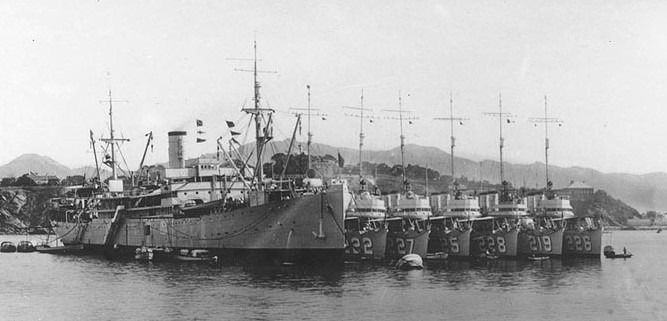
On 2 January 1934, Edsall sortied for Cebu (3-5 January) and then Iloilo (5-6 January) before returning to Manila Bay on the 7th. After three idle months, Edsall steamed for Japan with visits to Yokohama (16-25 April) and then Kobe (26 April-3 May) en route to Shanghai. Spending ten days in Shanghai (6-16 May), Edsall arrived at Chefoo on the 18th. She departed on 21 July, stopping at Weihaiwei [Weihai] (21-22 July) and returning to Chefoo (22-28 July). Underway again, she steamed to Tsingtao (29 July -11 August) before returning to Chefoo on 12 August. After several weeks in port, Edsall again called at Tsingtao (6-8 October) in advance of continuing to Woosung (8-9 October), Shanghai (19-29 October), Swatow (1-5 November), and Hong Kong (6-19 November) before returning to Manila Bay on 21 November to spend the remainder of 1934.
Edsall weighed anchor and resumed underway operations on 1 April 1935. The destroyer steamed to numerous locations around the Philippine archipelago before reaching Cebu on 6 April. Departing on 8 April, she steamed back into Manila on the 9th. Edsall then departed on 15 April for Shanghai (18-30 April) before transiting the East China Sea to visit Kobe (3-17 May). She returned to China, standing into Chefoo (19 May-19 June) and then visited Tsingtao (21-28 June), before steam back into Chefoo on 29 June. Remaining at Chefoo into August, Edsall steamed for Tsingtao on 3 August, continuing to Woosung (6 August) before returning to Manila Bay to undergo maintenance (10 August-10 October). With her yard work completed, she departed to visit Bangkok (15-22 October) in advance of port calls at Pakwan, Java, Netherlands East Indies (NEI) (22 October); and Saigon (24 October-2 November) before returning to Manila on 6 November.
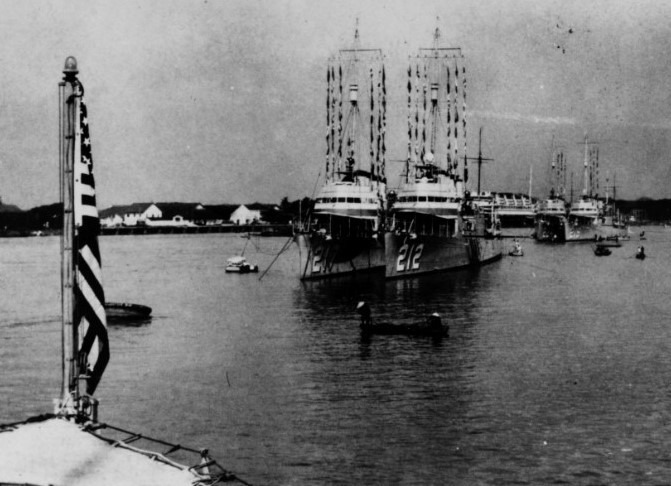
Edsall did not get underway again until 13 April 1936, departing Manila for Woosung (16-17 April). Resuming on the 17th, she stood at Shanghai (17 April-13 May) before continuing on to Chefoo (15 May-29 June). Departing for Tsingtao on 29 June, she returned to Chefoo the next day. She remained at Chefoo for most of July with the exception of a shuttle to Tsingtao (26-31 July). Back at Chefoo on 1 August, the destroyer stood out for Tangku [Tanggu] (22-28 August) and then returned to Chefoo (29 August-14 October). On 16 October, stood in to Shanghai, departing on 2 November. After spending a week at Hong Kong (5-12 November), Edsall steamed for Singapore, where she arrived on 16 November. Edsall departed on 23 November and returned to Manila Bay on the 27th. There she remained through the end of the year.
After several months in Manila Bay, Edsall sallied forth for a return to China on 18 April 1937. Reaching Shanghai on 22 April, she remained there until 6 May, when she departed for an extended time at Chefoo (8 May-16 August). During this time the Marco Polo Bridge Incident (7 July) prompted the outbreak of the Second Sino-Japanese War. With the war having begun, Edsall returned to the International Settlement at Shanghai (18 August-18 September). From her vantage point on the Yangtze, the destroyer’s crew witnessed the Japanese campaign to conquer the city (13 August-26 November). Throughout the remainder of September and the first three weeks of October, Edsall made six passages from Shanghai, patrolling the entrance to the Yangtze and the surrounding seas. On 24 October, she steamed for Woosung (24-25 October) before returning to Shanghai on the 26th. Two days later, Edsall weighed anchor for Yokohama, arriving on 31 October. She remained there until 6 November, when she got underway making her return to Shanghai on the 10th. The destroyer remained there until 5 December, when she weighed anchor and steamed to Tsingtao (6-17 December). During her time in port there, on 12 December, the U.S. river gunboat Panay (PR-5) and three Standard Oil tankers Mei Ping, Mei An, and Mei Hsia, came under attack from Japanese naval aircraft on the Yangtze near Nanking. After being hit by two of the eighteen 132-pound bombs dropped by three Yokosuka B4Y Type 96 bombers and strafed by nine Nakajima A4N Type 95 fighters, Panay sank. Edsall sortied on 18 December, steaming for the entrance to the Yangtze. Having arrived later that same day, she diverted and steamed back for the Philippines, arriving back at Manila Bay on 21 December. There she remained into the spring of 1938.
Underway again on 21 March 1938, Edsall steamed for a return to China and the continued hostilities between China and Japan. She moored off the Bund on the 24th. Having spent more than a month at Shanghai, she stood out on 28 April and steamed for Chefoo, arriving two days later. On 5 May, she was bound for Tsingtao, arriving the following day. After five days, the destroyer made for Shanghai (12 May), the Min River (13-19 May), and then on to Amoy, where she remained from 20 May through 16 June. Charting a course for Hong Kong, she arrived the next day and spent eleven days there in advance of returning to Amoy, 29 June. Edsall departed Amoy on 9 July and paused at Hong Kong (10-12 July) before returning to Manila Bay and remaining there, 14-30 July. Having put to sea again for training and trials on 30 July and 5-7 August, Edsall cleared Manila Bay on 9 August for two months cruising the archipelago’s southern islands conducting patrols and reconnaissance amidst the heightening tensions in Asia and the Pacific. She returned to Manila Bay on 22 October for a prolonged winter anchorage.
After more than five months in port, Edsall, cleared Manila Bay on 1 April 1939. Initially pausing at Swatow (3-14 April), she continued on to Hong Kong (15-17 April). Underway again on 17 April, she steamed into the Min River (18-22 April) before returning, via Hong Kong (23-28 April), to Swatow on the 29th. After three weeks there, the destroyer made for Hong Kong (20-22 May) before continuing on to Manila. Arriving the 24th, she remained a week and then steamed for Shanghai (3-16 June). She then proceeded to Chefoo, arriving on the 18th.
In the summer of 1939, Edsall made two voyages from Chefoo to Tsingtao ̶ the first, 2 July and the second, 5-18 August. Briefly returning to Tsingtao, she continued on to Peitaiho [Beidaihe] (19-26 August) before standing back into Chefoo on the 27th. Departing for Tsingtao on 1 September, she remained there (2-4 September) before steaming south and returning to Manila Bay on 8 September. The following day, she departed for Zamboanga (11-12 September) and Jolo (12-18 September). After shuttling between Zamboanga (18-20 September) and Jolo (20-28 September), she returned to Zamboanga (28-30 September) en route to standing back into Manila Bay on 2 October. Returning to sea on 6 October, she visited Polloc Harbor [Parang], Mindanao (7-11 October) before visits to Zamboanga (12 October; 13-20 October) and Jolo (13 October). Making her return to Manila Bay on the 22nd, she again put to sea (31 October-2 November) and then returned to Manila. Clearing on 16 November, she visited Polloc Harbor, a second time (19-30 November) in advance of making her return to Manila Bay on 2 December.
After several idle months, Edsall stood out from Manila Bay on 26 February 1940 and arrived in Hong Kong two days later. Departing on 1 March, she shuttled between Swatow (2-15 March; 22 March) and Hong Kong (16-21 March) before returning to Manila Bay on 24 March. Underway again in April, she cleared Manila (20-23 April; 24-25 April; and 29-30 April) for trials and training. Standing into Subic Bay to visit Olongapo (30 April-3 May), she docked at the Cavite Navy Yard and underwent maintenance (3 May- 24 June). After undocking, she conducted trials, 24-26 June and made her return to Manila Bay upon their conclusion. Three days later, on 29 June, she was underway, bound for Tsingtao. Arriving on 3 July, she remained there until 6 July, departing for Chefoo and arriving the next day. After 12 days, she cleared Chefoo and returned to Tsingtao (20 July-16 August), before standing back into Chefoo on 17 August. Having gone to sea, she visited Tsingtao and then departed there on 4 September. Cruising the Chinese coast, Edsall visited Chinwangtao (5-7 September); Peitaiho (7-10 September); Chefoo (10-12 September); Weihaiwei (12 September); Tsingtao (13-23 September); Shanghai (25 September-4 October); Amoy (6-7 October); and Swatow (8-9 October). She then departed China on the 9th and making her way back to the Philippines, steamed into Manila Bay on 11 October. Ten days later, she was again underway, steaming to various locations in the Philippine archipelago. Having departed on 21 October, the destroyer visited Zamboanga (22-25 October); Jolo City (25-26 October); Tutu Bay, Jolo (26 October-12 November); and returning to Manila on 16 November. She then went to sea on 9 December and, after nine days, returned to Manila Bay on 18 December to spend the Christmas and New Year’s holidays in port.
Shortly afterward, Edsall went to sea multiple times for short durations in the first month of 1941. She departed Manila and returned the same day on 6 January, 17 January, 20 January, and 22 January, respectively. It was not until 15 April, that she again departed Manila Bay to cruise Philippine waters. This was part of the ill-fated efforts by Adm. Thomas C. Hart, Commander in Chief, U.S. Asiatic Fleet, to prepare for a likely war with Japan. The destroyer stopped at multiple locations en route. These included pauses at Iloilo (16 April); Zamboanga (17-18 April); Polloc Harbor (19 April-2 May); Tutu Bay (3-9 May); Jolo City (9-11 May); and Tawi Tawi (11-23 May). She then returned to Manila Bay on the 25th.
In July 1941, the Japanese occupied the southern half of French Indochina and prompted a U.S. embargo on oil and scrap metal exports to Japan, further increasing tensions and the likelihood of conflict. Adm. Hart continued his attempts to ready the Asiatic Fleet for war. The 13 destroyers under his command, Destroyer Squadron 29 (DesRon 29), spent the succeeding months going to sea regularly to conduct training, surveillance, and reconnaissance patrols in the Philippine archipelago and surrounding waters.
On 24 November 1941, Adm. Hart dispatched Destroyer Division 57 (DesDiv 57) ̶ Whipple (DD-217) [flag], Edsall, Alden (DD-211), John D. Edwards (DD-216) along with the destroyer tender Black Hawk ̶ to the southeast Borneo oil port of Balikpapan, NEI. The other destroyer divisions in DesRon 29, DesDiv 58 and DesDiv 59, along with the light cruiser Marblehead (CL-12) were sent to Tarakan, Borneo, British North Borneo [Malaysia]. Ostensibly there to “refuel,” the detachments were prepared to respond to an anticipated Japanese offensive. On 27 November, Washington issued a “war warning.” Edsall’s emergency sailing had stranded GM1c Hugh M. Lovely, who had received a leave of absence starting on 22 November, in Manila. He would never rejoin his ship.
Anticipating the Japanese gambit, Adm. Sir Tom S.V. Phillips, RN, Commander, British Far East Fleet, arrived in Manila on 5 December 1941 for a secret two-day conference with Lt. Gen. Douglas MacArthur, Commander, U.S. Army Forces in the Far East (USAFFE) and Hart. This meeting was to discuss the United States’ assurances of assistance to the British in the event of a Japanese move in Southeast Asia. Adm. Phillips wanted Hart to “loan” him two destroyer divisions to be sent to Singapore. Not wishing to provoke the Japanese (whose invasion forces were already underway). Instead, Hart informed Phillips that the destroyers were already deployed and would be dispatched accordingly in response to a Japanese attack. On 6 December aerial reconnaissance patrols spotted a large Japanese convoy steaming south in the Gulf of Siam. Adm. Phillips soon returned to Singapore to join his flagship.
When the Japanese launched their strategic offensive on 8 December 1941 (local time), Edsall (Lt. Joshua J. Nix, commanding) was preparing for action with DesDiv 57 at Balikpapan. With news of the attack on Pearl Harbor, Adm. Harold R. Stark, Chief of Naval Operations, issued instructions to “Execute War Plan 46 against Japan.” The division raced to Singapore, arriving on 10 December. There she embarked Lt. Robert Henry Hume Webber, RN, a British liaison officer, and four British sailors, and, with her sister ships, set course later that same day to search for survivors of the British “Force Z,” the battleship HMS Prince of Wales and the battlecruiser HMS Repulse, that had been sunk off Malaya [Malaysia] that same day by Japanese Mitsubishi G3M Type 96 Rikko [Nell] and Mitsubishi G4M Navy Type 1 [Betty] bombers based in southern French Indochina [Vietnam]. On the return voyage (11 December) Edsall intercepted the Japanese fishing trawler Shofu Fu Maru with four small sampans in tow and escorted them toward Singapore, turning them over to an Australian warship before the destroyer maneuvered to pass through the minefields. Having then disembarked her Royal Navy liaison contingent, Edsall sailed on the morning of 14 December.
While standing out, however, Edsall fouled a submerged object at 1150; sailors in the after engine room heard a scraping sound, while the helmsman on the bridge reported the “rudder jammed at left ten degrees.” Both engines were ordered stopped, while steering control was shifted to the steering engine room. Maneuvering by use of engines to remain in the channel, Edsall, conned from the bridge and with the steering engine room controlling her helm, the ship passed out between the boom nets at 1220 and came to a stop. Visual inspection of the rudder showed no damage, the rudder having full throw left and right, while steering being shifted to the bridge revealed no problems. Lt. Nix postulated that the ship had encountered “a sunken log, stump, or some such object [that] made contact with the bottom of this vessel and possibly caught on the rudder,” temporarily jamming it “at about ten degrees left.” Stopping the engines then probably caused the object to drop free. Maneuvering with the engines proved “very easy” and the steering engine room immediately established control. “The performance of the ship,” Nix concluded, “has been entirely satisfactory since this incident and it is believed no damage was incurred.” Edsall experienced no trouble during the remainder of her trip in those waters.
She then joined heavy cruiser Houston (CA-30) at Soerabaja [Surabaya], Java, NEI, to escort shipping retiring to the relative safety of Darwin, Northern Territory, Australia. While so serving, she became the first U.S. destroyer to sink an enemy submarine in World War II. On 20 January 1942, while escorting the oiler Trinity (AO-13) in company with Alden, Edsall, in concert with three Australian corvettes and assisted by a Grumman OS2U Kingfisher from Langley (AV-3), Edsall sent I-124 (Lt. Cmdr. Kishigami Koichi in command) to the bottom on 20 January 1942 off Darwin. Lt. Nix praised RM1c Paul W. Hegerfeldt, who had been on board since 29 March 1941, for his “excellent work and efficient operation [of Edsall’s] sound gear.”
Soon thereafter, on 23 January 1942, Edsall attacked another submarine contact in the Howard Channel, Clarence Strait. The maneuvering enemy and the limited space of the channel, as well as the necessity of making a sharp turn, forced Lt Nix to order depth charges dropped at a speed of eight knots. The depth charges, set at a depth of fifty feet, “caused considerable jarring of this ship.” After assessing the damage his ship had received, however, Nix asserted confidently: “the above damage does not in any way affect the ‘Readiness for War’ condition of the Edsall.”
Continuing to escort convoys in a race against time, Edsall carried out attacks on submariner contacts off Tjilatjap on 19, 20, and 21 February 1942, without success. She gamely continued to operate off Java, her crew augmented by four sailors from Stewart, who joined via Parrott on 22 February. On 26 February, she cleared Tjilatjap to rendezvous with Langley, which was ferrying USAAF Curtiss P-40 Warhawks for the defense of Java. On the 27th, the seaplane tender along with Edsall and Whipple (DD-217) were attacked by nine large twin-engine bombers which damaged Langley so badly, she had to be abandoned and scuttled.
| commanding Officers | Dates of Command |
| Cmdr. Arthur H. Rice Jr. | 26 November 1920 – 23 June 1921 |
| Lt. Robert G. Tobin | 23 June 1921 – 29 August 1921 |
| Lt. Cmdr. Harry R. Bogusch | 29 August 1921 – 10 October 1921 |
| Lt. Ray P. Helm | 10 October 1921 – 25 November 1921 |
| Lt. Cmdr. William C. I. Stiles | 25 November 1921 – 3 June 1922 |
| Cmdr. Halsey Powell | 3 June 1922 – 17 May 1923 |
| Lt. Cmdr. Robert T. Young | 17 May 1923 – 18 December 1924 |
| Lt. Cmdr. Lemuel E. Lindsay | 18 December 1924 – 25 October 1927 |
| Cmdr. Jules James | 25 October 1927 – 3 February 1928 |
| Cmdr. Chauncey A. Lucas | 3 February 1928 – 19 December 1928 |
| Lt. Cmdr. Thomas C. Slingluff | 19 December 1928 – 17 July 1930 |
| Lt. Cmdr. Byron S. Dague | 17 July 1930 – 23 February 1932 |
| Lt. Cmdr. Bruce P. Flood | 23 February 1932 – 25 November 1932 |
| Lt. Cmdr. Walker Cochran | 9 February 1933 – 27 February 1934 |
| Lt. Cmdr. Frederick D. Powers | 27 February 1934 – 17 February 1935 |
| Lt. Andrew M. Parks | 17 February 1935 – 25 June 1935 |
| Lt. Cmdr. Charles A. Baker | 25 June 1935 – 4 May 1937 |
| Lt. Cmdr. Philip R. Kinney | 4 May 1937 – 24 July 1937 |
| Lt. William S. Veeder | 24 July 1937 – 9 August 1937 |
| Cmdr. Anton B. Anderson | 9 August 1937 – 30 September 1937 |
| Lt. Cmdr. Frederick S. Conner | 30 September 1937 – 2 February 1939 |
| Lt. Cmdr. Abel C. J. Sabalot | 2 February 1939 – 15 June 1940 |
| Lt. Cmdr. Edwin M. Crouch | 15 June 1940 – 13 October 1941 |
| Lt. Joshua J. Nix | 13 October 1941 – 1 March 1942 |
Christopher B. Havern, Sr., Christopher K. Hemler, and Robert J. Cressman

Edsall picked up 177 survivors, Whipple 308. On the 28th the two destroyers rendezvoused with Pecos (AO-6) off Flying Fish Cove, Christmas Island. More Japanese bombers forced Edsall to depart before transferring all of Langley’s survivors, but she completed the job on 1 March, then set course to return to Tjilatjap to deliver the USAAF pilots from the 33rd Pursuit Squadron (Provisional) embarked on board.
The old destroyer was instead intercepted by Adm. Nagumo Chuichi’s Kido Butai (Striking Force) and fought a hopeless action against an overwhelming force consisting of the battleships Hiei and Kirishima and the heavy cruisers Tone and Chikuma. The Japanese under the command of Vice Adm. Mikawa Gunichi, Commander, 8th Cruiser Division, discovered the lone destroyer and initiated the action against what they believed to be a “Marblehead-type light cruiser.”
In the running battle that ensued, Lt. Nix, the destroyer’s commanding officer, deployed smoke and skillfully maneuvered his ship, displaying “energy, initiative, and persistence” as he had in carrying out attacks on Japanese submarines. Although significantly outranged, Edsall’s 4-inch guns still returned fire. Nix also launched his limited torpedoes, only narrowly missing Chikuma. The Japanese fired over 1,300 14-inch, 8-inch, and 5-inch shells before calling in an air strike of 26 Aichi Type 99 Kanbakus from the carriers Kaga, Hiryū, and Soryu. Before she finally lost all power, Edsall defiantly faced her bow toward the enemy before going down by the stern. Capsizing, she rolled over and slipped beneath the waves around 1900.
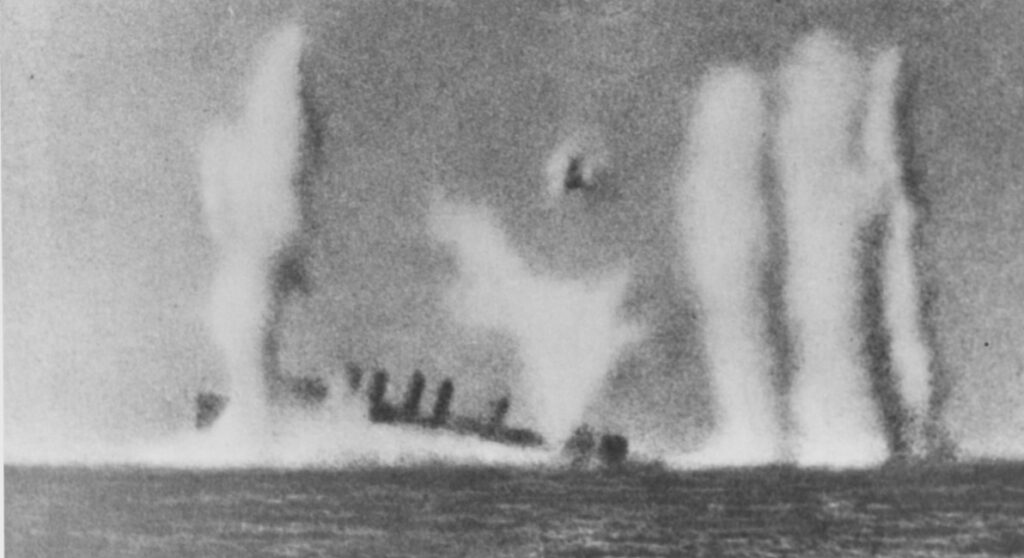
Chikuma rescued a small number of sailors (estimated at between six and eight) from Edsall’s crew, who were initially declared missing due to enemy action as of 1 March 1942. Their fate remained unknown throughout the war, and all were declared presumed dead on 25 November 1945. During war crimes trials in 1946, however, six of Edsall’s enlisted crew’s remains (five in one mass grave and a sixth buried nearby), and possibly five of the USAAF pilots embarked, were located in mass graves near Kendari II Airfield, Celebes, N.E.I. As determined later, all had been beheaded around the end of March 1942. None of the gallant destroyer’s crew or passengers survived the war. Those six sailors whose remains were identified positively from identity discs, were: F1c Sidney G. Amory, MM1c Horace W. Andrus, MM2c “J””R” Cameron, S2c Loren S. Myers, MM3c Larry Vandiver, and F1c Donald F. Watters.
Edsall was stricken from the Navy Register on 8 May 1942.
The Royal Australian Navy discovered the wreckage of Edsall in the Indian Ocean off the coast of Christmas Island and notified NHHC on 13 May 2024.
Edsall received two battle stars for her World War II service: the first for her participation in the Philippine Islands operation (8 December 1941-1 March 1942), and the second for her role in sinking I-124 (20 January 1942).
Discover more from THE CHESAPEAKE TODAY - ALL CRIME, ALL THE TIME
Subscribe to get the latest posts sent to your email.





